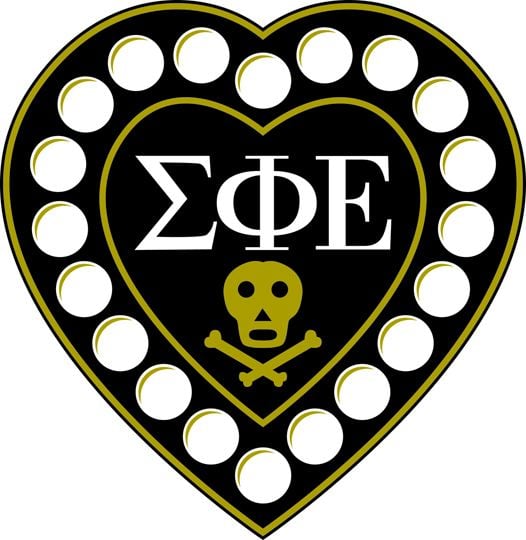Mission statement Building Balanced Men Founded 1 November 1901 Chapter 221 | Scope National Colors Purple and Red Color Purple and Red | |
 | ||
Symbol Skull and Crossbones within a Black Heart Founders Richard Spurgeon Owens, Edgar Lee Allen Similar Phi Mu, Pi Kappa Phi, Alpha Phi, Sigma Sigma Sigma, Phi Iota Alpha Profiles | ||
Sigma Phi Epsilon (ΣΦΕ), commonly abbreviated SigEp or SPE, is a social college fraternity for male college students in the United States. It was founded on November 1, 1901, at Richmond College (now the University of Richmond), and its national headquarters remains in Richmond, Virginia. It was founded on three principles: Virtue, Diligence, and Brotherly Love (often abbreviated as "VDBL"). Sigma Phi Epsilon is one of the largest social fraternities in the United States in terms of current undergraduate membership.
Contents
- Csun sigma phi epsilon rush 2016
- Founding
- Badge and colors
- Acceptance of transgender members
- Controversies
- Chapters
- References

Csun sigma phi epsilon rush 2016
Founding

In the fall of 1900 18-year-old divinity student Carter Ashton Jenkens, the son of a Baptist minister, transferred from Rutgers College of New Jersey to Richmond College, a Baptist institution in the Virginia capital. At Rutgers Jenkens had been initiated into the Chi Phi Fraternity. At Richmond, which did not have a chapter of Chi Phi, Jenkens was part of group of friends who were meeting regularly under the unofficial name the "Saturday Night Club". By early October, 1901, Jenkens had persuaded the group, which had grown to twelve men, to try and establish a chapter of Chi Phi at Richmond. These men were reportedly spurned by the existing fraternities on campus for their sense of morality (seven of the twelve were studying for the ordained ministry) and for their rural, middle-class backgrounds. Jenkens had convinced the others that their chapter could be different from the other fraternities on campus and assured them that Chi Phi's principles were in line with their own. The group's request for a charter, however, was met with refusal as the national fraternity felt that Richmond College was too small to host a Chi Phi chapter. Jenkens and his friends therefore founded their own fraternity.

After several secret meetings throughout October 1901, the new fraternity took shape and on November 1, 1901, the fraternity's first membership roster was publicly posted at the school. It listed the twelve founding members in this order: Carter Ashton Jenkens, Benjamin Donald Gaw, William Hugh Carter, William Andrew Wallace, Thomas Temple Wright, William Lazelle Phillips, Lucian Baum Cox, Richard Spurgeon Owens, Edgar Lee Allen, Robert Alfred McFarland, Franklin Webb Kerfoot and Thomas Vaden McCaul. After much discussion, the group settled on a secret motto and called their fraternity Sigma Phi.

Jenkens, Gaw and Phillips then met with a faculty committee to seek official recognition for their new fraternity. The faculty members were reluctant to recognize a sixth fraternity in a school with only 300 students, especially as more than half the members would be soon-to graduate seniors. Additionally, another national fraternity already existed using the name Sigma Phi. The founders responded that their new fraternity would be different from the others at Richmond, as was being founded upon biblical, egalitarian principles, and new members would quickly be taken in from the undergraduate classes to increase the new fraternity's size, and the fraternity's name was still open to debate. With these assurances from the founders, the faculty committee approved the new fraternity's request for official recognition. Shortly afterwards, the founders met and decided to rename the fraternity Sigma Phi Epsilon.
Badge and colors

The colors dark red and royal purple were chosen to represent fraternity, while the golden heart was chosen as the fraternity's symbol. The principles of Virtue, Diligence and Brotherly Love, were chosen as "The Three Cardinal Principles". Jenkens also designed the fraternity's badge as a golden heart surmounted by a black enameled heart-shaped shield. Upon the shield are inscribed, in gold, the Greek-letters of the fraternity, ΣΦΕ, and below these letters, a skull and crossbones. The meaning of these symbols is divulged during the initiation ritual and known to members only. The founders' badges were designed and ordered before the addition of "Epsilon" to the fraternity's name. Thus they had only a "Sigma" and a "Phi" inscribed on the lobes of the heart, with the skull and crossbones below. A last-minute telegraph sent to the jeweler requested that an "Epsilon" be added "somewhere" on the already-complete badges, so the jeweler replaced the bottom-most gemstones with a black enameled "Epsilon." The badges of founders Carter and McCaul are on display at the Sigma Phi Epsilon headquarters at the fraternity's headquarters.
Acceptance of transgender members
In December 2014, Sigma Phi Epsilon became the first fraternity in the North-American Interfraternity Conference to accept transgender men as members. The National Board of Directors passed the policy by an 8-0 majority vote with three abstentions.
Controversies
In August 2016, member Dan Drill was sentenced to 74 months in prison after pleading guilty to two counts of rape.
In March 2016, the chapter at Purdue University was placed on suspension until 2020 for severe hazing, alcohol violations, and non-compliance with university rules.
In September 2015, a Sigma Phi Epsilon member at the West Virginia University (WVU) was arrested for allegedly raping a WVU female student at the fraternity's chapterhouse. He faces up to 25 years of prison for the felony charge.
In October 2015, Sigma Phi Epsilon revoked the charter of the Jacksonville State University chapter due to hazing and other alleged actions including racism and sexual misconduct. The chapter was ordered to cease operations for three years and remove itself off-campus if the chapter was to be re-activated.
In 2014, the Sigma Phi Epsilon chapter of the University of Mississippi was closed after three of its members were said to have draped a noose around the statue of James Meredith, the first black student to attend the university.
In September 2014, Tucker Hipps, of Clemson University located in Clemson, South Carolina was found dead in Lake Hartwell after his pledge brothers reported him missing after a run that morning. Both the university and the national fraternity found that the chapter had violated its code of conduct. The investigation is ongoing. In February 2015, Clemson chapter was given a five-year suspension for alleged violations of the student organization conduct code after the death of Hipps.
In February 2014, two sexual assaults were reported at the Yale SigEp chapter fraternity house one block from campus. The fraternity had allowed their facility to be used by another student group for a private event. According to the fraternity, the allegations were not made against members of the chapter.
In January 2014, 178 grams of marijuana and .21 grams of cocaine were seized from the fraternity house at University of North Carolina at Chapel Hill. One fraternity member was arrested and charged for drug possession and intent to sell.
In 2013, the fraternity was suspended for two years at Southern Methodist University after torturing a Hispanic fraternity member of Lambda Chi Alpha for four hours. Four Sigma Phi Epsilon members were arrested and charged with assault for kicking, punching, spraying Formula 409 on wounds and cuts, making racist comments, and holding the Lambda Chi Alpha member captive against his will.
In August 2011, the National Board of Directors of Sigma Phi Epsilon voted to support criminal prosecution of anyone hazing members.
In 2011, three Sigma Phi Epsilon members from East Carolina University were arrested and charged with several offenses for possession of 49 grams of marijuana, three Adderall pills, and a dozen stolen street signs at their fraternity house.
In 2007, four members of the fraternity were arrested from Florida State University for hazing when the police found 31 pledges shivering in 30 degree weather and covered in raw eggs, catfish-stink bait, flour and vinegar, and their bodies were red with welts.
